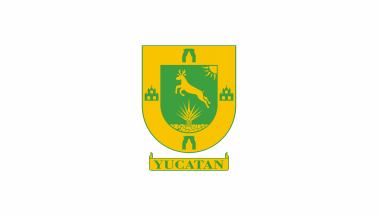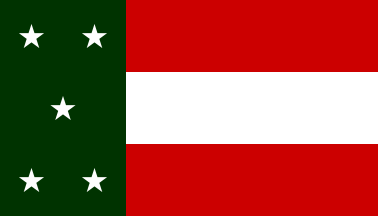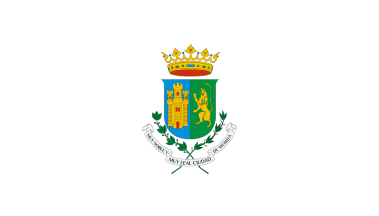
De facto flag of Yucatan
by Juan Manuel Gabino Villascán, May 06, 2001.

Last modified: 2019-12-14 by juan manuel gabino villascán
Keywords: mexico | yucatan | deer | henequen | maya | yucantan (republic of) | castas war | spaniard |
Links: FOTW homepage |
search |
disclaimer and copyright |
write us |
mirrors

De facto flag of Yucatan
by Juan Manuel Gabino Villascán, May 06, 2001.
INEGI and SEP

.gif)
The coat of arms consists of an "iberian" shield (round
pointed with parallel sides and flat top), vert, a deer or
leaping from the sinister over an unidentified charge on a mound, all under
a sun placed in the sinister canton, all of the same; bordure or charged
with two churches, sinister and dexter, and two castle towers, top and bottom,
all or lined vert. Bellow the shield, a scroll with the isncription
"YUCATÁN" in black capitals.
António Martins, 22 Jun 1999
Though the adoption of the new arms; at "Los Pinos", e.g. the President's residence, is still hoisted a white flag
charged with the former arms.
Juan Manuel Gabino Villascán, May 06, 2001.

by Juan Manuel Gabino Villascán, May 06, 2001.
"The most accurate version about the meaning of the five-star flag is that given by Historian Rodolfo Menéndez de la Peña, who wrote a brief introduction on the cover of the Serapio Baqueiro's book entitled 'Ensayo Histórico sobre las Revoluciones de Yucatán de 1840 a 1864' (Historic esay on the Yucatán revolutions from 1840 to 1864); the texts says: '...the Yucatán flag is divided into two fields: to the left, one field in green, and to the right, another divided in turn into three, red (top and bottom) and white (middle). The green area is featured by five beautiful stars standing for the five departments into wich Yucatán was administrativelly divided by Decree of November 30, 1840: Mérida, Izamal, Valladolid, Tekax and Campeche...' According the year on which the Peninsula was divided into five departments or districts, Writer José Antonio Adonay Cetina Sierra poits out another date in his work 'Apuntaciones para la Historia Legislativa del Municipio de Mérida' (Notes for the Legislative History of the Municipality of Mérida): 'It was then when Yucatán decreed on May 24, 1837 a new territorial division that reduced to five districts the then in effect colonial system; the town were distributed and in some cases the politic and administrative jurisdiction were enlarged: first district of Mérida, Department's capital; second district of Campeche; third district of Valladolid; fourth district of Izamal; and fifth district of Tekax'"
"Respecting the Yucatanense flag it was displayed by a short time at the Palace of the Government, according to Mr. Espejo, we count with the following information supplied by Writer Juan Francisco Molina Solís in his work "History of Yucatán" vol. 1; page 177: 'On night of March 16, 1841, during a meeting for the installation fo the Mérida Constitutional Council, the main room was invaded by an unarmed crowd, led by Barbachano, Francisco Martín Peraza and some others, asking for the full independence of Yucatán; then the Council under the crowd's presure agreed to review the proposal, (...) some of the most exitated people clang to the Palace's roof and after downining the Mexican flag hoisted that of Yucatan.' (...)"
"After six months (?) (it should be say -seven months-) and four days when the flag of Yucatán appeared, then October 20, 1841, the Congress of Yucatán proclaimed the Independence of the Peninusula from the Centralist Mexican Government, and starts to use the Peninsula flag as its symbol before the world nations, flying it at the merchant and military ships, as soon as the public buildings until December 15, 1843, when the Yucatanense government signs a Peace and Friendship Agreement with the Mexican counterpart, stating in the article 15 the following:
'Article 15: Yucatán shall not use any flag but that of the nation (...)'...".
From José Susano Durán Esquivel, "Las estrellas y la vigencia de la bandera de Yucatán" [The stars and the effect of the flag of Yucatan]
in
160 aniversario de la Bandera de Yucatán
Quoted and translated by Juan Manuel Gabino Villascán, July 21, 2001
The flag is divided in two fields. The hoist side bears, to my
rough calculations (could only get an artistic rendition and photos
with no regular sizes) a bit more than a third of the flag; this is a
green field, with five white five-pointed stars, arranged 2-1-2 (from top to bottom).
The fly is divided in three stripes: upper and lower in dark red,
and a central and wider one in white. Again, the proportions
might be worng, but that's more or less what the flag looks like.
Today, it is extensively used by the Yucatan public, seen on t-shirts,
stickers and bumperstickers, sport jackets and so on.
Guillermo Aveledo, 19 August 2000.
I have had exactly the same problems. It appears that, the flag of Yucatan is one of the most popular unofficial flags of Mexican states. I have visited all web sites refered here on this topic, and all show the same design with the wide variation refered by Guillermo:
António Martins, 23 September 2000.
At present it is seen everywhere as part of a tourist
campaign of the state
government.
Carlos Magaña Lara, 13 December 2000.
The flag is flown by Yucatan young athletes during national sports events such as the National Olympics [Olimpiada Nacional].
Juan Manuel Gabino Villascán May 10, 2014.

Like most of the Mexican states, Yucatán first used as arms those granted to its
capital city, e.g. Mérida: "A Spanish shield parted, the firts pale (left) azur charged by a castle in gold, and the
second pale (right) a rampant lion in gold on sinople (green). The top is a royal
crown. The ribbon bellow the shield bear the motto: "Muy noble y muy leal ciudad de
Mérida".
From: Escudo de Armas de Mérida, Yucatán [Extenal link not available anymore!]
Quoted and translated by Juan Manuel Gabino Villascán, May 06, 2001.
Anything below this line was not added by the editor of this page.